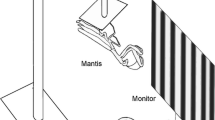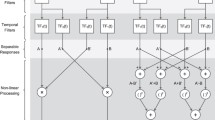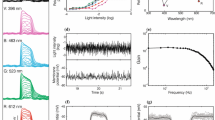Abstract
Larvae of tiger beetles (Coleoptera: Cicindelidae) are burrow-dwelling, visual ambush predators which withdraw into their burrows with the passing of large objects. Laboratory experiments confirmed that stimulation of each of the four principal stemmata can elicit escape and that the necessary visual stimulus is contracting, expanding, or transverse movement of a high-contrast image. Response frequency increases as a power function of contrast. Whole-field dimming is ineffective. Movement of large images composed of multiple texture elements, e.g., checkerboards, does not elicit escape, even if each element is much larger than the system's minimum visible angle (4–8° depending upon image contrast). In pilot experiments with a single figure before a textured background, coherent movement of the two inhibits escape, whereas motion in opposite directions does not. Thus, the processing mechanism functions as a feature detector and directs a response to large, single, moving objects.
Similar content being viewed by others
References
Bierbrodt, E. (1942). Der Larvenkopf vonPanorpa communis L. und seine Verwandlung mit besonderer Berücksichtigung des Gehirns und der Augen.Zool. Jhb. (Anat.) 68: 49–136.
Braitenberg, V., and Taddei-Ferretti, C. (1966). The landing reaction ofMusca domestica induced by visual stimuli.Naturwissenschaften 53: 155.
Coggshall, J. (1972). The landing response and visual processing in the milkweed bug,Oncopeltus fasciatus. J. Exp. Biol.57: 401–413.
Constantineau, M. (1930). Die Aufbau der Sehorgane bei den im Susswasser lebenden Dipterenlarven und bei Puppen und Imagines vonCulex.Zool. Jhb. (Anal.) 52: 251–346.
Demoll, R., and Scheuring, L. (1912). Die Bedeutung der Ocellen der Insekten.Zool. Jhb. (allg. Zool.) 31: 519–628.
Dethier, V. G. (1943). The dioptric apparatus of lateral ocelli. II. Visual capacities of the ocellus.J. Cell. Comp.Physiol. 22: 115–126.
Faasch, H. (1968). Beobachtung zur Biologie und zum Verhalten vonCicindela hybrida undCicindela campestris und experimentelle Analyse ihres Beutefangverhaltens.Zool. Jhb. (Syst.) 95: 477–522.
Folger, H. T. (1946). The reactions ofCulex larvae and pupae to gravity, light, and mechanical shock.Physiol. Zool. 19: 190–202.
Friederichs, H. F. (1931). Beiträge zur Morphologie und Physiologie der Sehorgane der Cicindeliden (Coleoptera).Z. Morph. Ökol. Tiere 21: 1–172.
Glantz, R. M. (1974). The visually evoked defense reflex of the crayfish: Habituation, facilitation, and the influence of picrotoxin.J. Neurobiol. 5: 263–280.
Hamilton, C. C. (1925). Studies on the morphology, taxonomy, and ecology of the larvae of holarctic tiger beetles (family Cicindelidae).Proc. U.S. Natl. Mus. 65(17): 1–87.
Hess, C. (1915). Untersuchung über den Lichtsinn bei Echinodermen.Pflüger Arch. Physiol. 160: 1–26.
Hori, M. (1982). The biology and population dynamics of the tiger beetle,Cicindela japonica (Thunberg).Physiol. Ecol. Jpn. 19: 77–212.
Hundertmark, A. (1936). Helligkeits- und Farbenunterscheidungsvermögen der Eiraupe der Nonne(Lymantria monacha L.).Z. Vergl. Physiol. 24: 42–57.
Hundertmark, A. (1937). Das Formunterscheidungsvermögen der Eiraupe der Nonne (Lymantria monacha).Z. Vergl. Physiol. 24: 563–582.
Jennings, H. S. (1976).Behavior of Lower Organisms, Indiana University Press, Bloomington.
Kelly, D. H. (1976). Pattern detection and the two-dimensional Fourier transform: Flickering checkerboards and chromatic mechanisms.Vis. Res. 16: 277–287.
Kuster, J., and Evans, W. (1980). Visual fields of the compound eyes of four species of Cicindelidae (Coleoptera).Can. J. Zool. 58: 326–336.
Land, M. F. (1985a). The eye: Optics. In Kerkut, G. A., and Gilbert, L. E. (eds.),Comprehensive Insect Physiology, Biochemistry, and Pharmacology, Vol. 6, Pergammon, Oxford, pp. 225–275.
Land, M. F. (1985b). The morphology and optics of spider eyes. In Barth, F. G. (ed.),Neurobiology of Arachnids, Springer-Verlag, Berlin, pp. 53–78.
Meyer, E. M. (1981). The capture efficiency of flickers preying on larval tiger beetles.Auk 98: 189–191.
Meyer, H. (1971). Visuelle Schlüsselreize für die Auflösung der Beutefanghandlung beim Bachwasserläufer,Velia caprai (Hemiptera: Heteroptera). I. Untersuchung der räumlichen und zeitlichen Reizparameter mit formverschiedenen Attrappen.Z. Vergl. Physiol. 72: 260–297.
Meyer-Rochow, V. B. (1974). The structure and function of the larval eye of the sawflyPerga.J. Insect Physiol. 20: 1565–1591.
Miller, W. H. (1979). Intraocular filters. In Autrum, H. (ed.),Handbook of Sensory Physiology, Vol. VII/6A. Comparative Physiology and Evolution of Vision in Invertebrates. Invertebrate Photoreceptors, Springer-Verlag, Berlin, pp. 69–143.
Palmer, M. K. (1978). Growth rates and survivorship of tiger beetle larvae.Cicindela 10: 49–66.
Palmer, M. K. (1979). Rearing tiger beetles in the laboratory.Cicindela 11: 1–11.
Palmer, M. K. (1982). Biology and behavior of two species ofAnthrax (Diptera: Bombyliidae), parasitoids of the larvae of tiger beetles (Coleoptera: Cicindelidae).Ann. Entomol. Soc. Am. 75: 61–70.
Paulus, H. F. (1979). Eye structure and the monophyly of the Arthropoda. In Gupta, A. P. (ed.),Arthropod Phylogeny, Van Nostrand Reinhold, New York, pp. 299–383.
Pearson, D. L., and Knisley, C. B. (1985). Evidence for food as a limiting resource in the life cycle of tiger beetles (Coleoptera: Cicindelidae).Oikos 45: 161–168.
Pearson, D. L., and Stemberger, S. (1980). Competition, body size, and the relative energy balance of adult tiger beetles (Coleoptera: Cicindelidae).Am. Midl. Nat. 104: 373–377.
Pilgrim, R. L. C. (1967). Some responses to light in a specimen ofPelagohydra mirabilis Dendy, 1902 (Coelenterata: Hydrozoa).J. Exp. Biol. 46: 491–497.
Richards, W. (1975). Visual space perception. In Carterette, E. C., and Friedman, M. P. (eds.),Handbook of Perception, Vol. 5. Seeing, Academic Press, New York, pp. 351–386.
Saxena, K. N., and Khattar, P. (1977). Orientation ofPapilio demoleus larvae in relation to size, distance, and combination pattern of visual stimuli.J. Insect Physiol. 23: 1421–1428.
Schiff, W. (1965). Perception of impending collision: A study of visually directed avoidant behavior.Psychol. Monogr. 79: 1–26.
Schöne, H. (1953). Farbhelligkeit und Farbunterscheidung bei den WasserkäfernDytiscus marginalis, Acilius sulcatus, and ihren Larven.Z. Vergl. Physiol. 35: 27–35.
Siegel, S. (1956).Nonparametric Statistics, McGraw-Hill, New York.
Sokal, R. R., and Rohlf, J. F. (1969).Biometry, W. H. Freeman, San Francisco, Calif.
Thorpe, W. H. (1944). Some problems of animal learning.Proc. Linn. Soc. (Lond.) 156: 70–83.
Unteutsch, W. (1937). Über den Licht- und Schattenreflex des Regenwurms.Zool. Jhb. (allg. Zool.) 58: 69–112.
von Buddenbrock, W. (1930). Untersuchungen über den Schattenreflex.Z. Vergl. Physiol. 13: 164–213.
Westheimer, G. (1972). Visual acuity and spatial modulation thresholds. In Jameson, D., and Hurvich, L. M. (eds.),Handbook of Sensory Physiology, Vol. VII/4. Visual Psychophysics, Springer-Verlag, Berlin, pp. 170–185.
Willis, H. L. (1967). Bionomics and zoogeography of tiger beetles of saline habitats in the central United States (Coleoptera: Cicindelidae).Univ. Kam. Sci. Bull. 47: 145–313.
Wilson, E. O., and Farish, D. J. (1973). Predatory behavior in the antlike waspMethoca stygia (Say) (Hymenoptera: Tiphiidae).Anim. Behav. 21: 292–295.
Yamamoto, K., and Toh, Y. (1975). The fine structure of the lateral ocellus of the dobsonfly larva.J. Morphol. 146: 415–430.
Yerkes, A. W. (1906). Modifiability of behavior inHydroides dianthus V.J. Comp. Neurol. Psychol. 16: 441–449.
Zikan, J. J. (1929). Zur Biologie der Cicindeliden Brasiliens.Zool. Anz. 82: 269–414.
Author information
Authors and Affiliations
Rights and permissions
About this article
Cite this article
Gilbert, C. Visual determinants of escape in tiger beetle larvae (Cicindelidae). J Insect Behav 2, 557–574 (1989). https://doi.org/10.1007/BF01053354
Accepted:
Issue Date:
DOI: https://doi.org/10.1007/BF01053354




